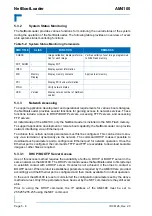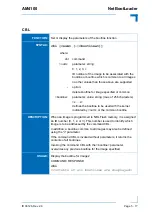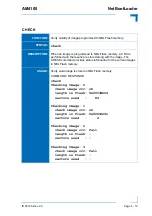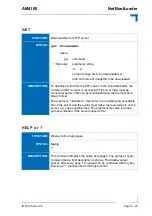
NetBootLoader
AM4100
Page 5 - 12
ID 36126, Rev. 2.0
P R E L I M I N A R Y
If the image is an operating system (which is the default case), it must be programmed without
an offset. When such an image is programmed to NBL Flash memory, the image length and
CRC information is also programmed along with the image. This information is used by the Net-
BootLoader to determine the validity of the image during the boot operation. During system
startup, a valid image is copied to DDR2-SDRAM address 0x0 and started at offset 0x0 (FDT
enabled) or 0x100 (FDT disabled).
If an offset is specified, the image will be programmed exactly at this offset without adding
length or CRC information. This option is intended for the storing of configuration information
which is required to be located in NBL Flash memory.
When programming the NetBootLoader Flash memory using offsets (with the -o option), it is
possible to unintentionally overwrite portions of previously programmed images. This may re-
sult in either an invalid image or erroneous data contents of the NetBootLoader Flash memory.
It is recommended to first verify the contents of the NetBootLoader Flash memory using the
INFO command before performing any programming with offsets. Refer to the INFO command
for further information.
5.4.5.2
Programming an Image
The image itself must be compiled and linked to run from the DDR2-SDRAM base address 0x0
of the CPU. The entry point of the executable PPC code must be at offset 0x0 (FDT enabled)
or 0x100 (FDT disabled).
Gaining access to the image for programming to NBL Flash memory depends on where it is
located. The NetBootLoader can access four different sources for images:
•
TFTP server
•
FTP server
•
Motorola S-Records
•
memory within the visible address range of the AM4100
The NetBootLoader uses a single data buffer for downloading an image from a TFTP server,
FTP server, or an image as Motorola S-Records. These images must first be downloaded to
the data buffer prior to being programmed to NBL Flash memory. An image located within the
visible address range of the AM4100 is directly accessible for programming.
To access an image located on a TFTP server, the TFTP command is used. To access an im-
age located on an FTP server, the GET command is used. To perform Motorola S-Record ac-
quisition, the SL (SLoad) command is used. Once the image is in the data buffer, the NBL Flash
memory is programmed using the LF (Load Flash) command. For an image within visible mem-
ory, the LF command is used to program directly to NBL Flash memory.
5.4.5.3
Accessing TFTP and FTP Servers
To gain access to an image file stored on a TFTP or FTP server an Ethernet port is used. Im-
ages are downloaded to the data buffer using the FTP protocol. To use these interfaces, the
Ethernet port parameters must first be set, and the operator must have control of the NetBoot-
Loader.
To download an image from a TFTP server, the command TFTP is used. The TFTP server IP
and file name of the image must be known and provided to the TFTP command or be provided
by the DHCP server via the DHCP command.
Summary of Contents for AM4100
Page 19: ...AM4100 Introduction ID 36126 Rev 2 0 Page 1 1 Introduction Chapter 1 1 P R E L I M I N A R Y...
Page 57: ...AM4100 Installation ID 36126 Rev 2 0 Page 3 1 Installation Chapter 1 3 P R E L I M I N A R Y...
Page 65: ...AM4100 Configuration ID 36126 Rev 2 0 Page 4 1 Configuration Chapter 1 4 P R E L I M I N A R Y...
Page 89: ...AM4100 NetBootLoader ID 36126 Rev 2 0 Page 5 1 NetBootLoader Chapter 1 5 P R E L I M I N A R Y...
















































